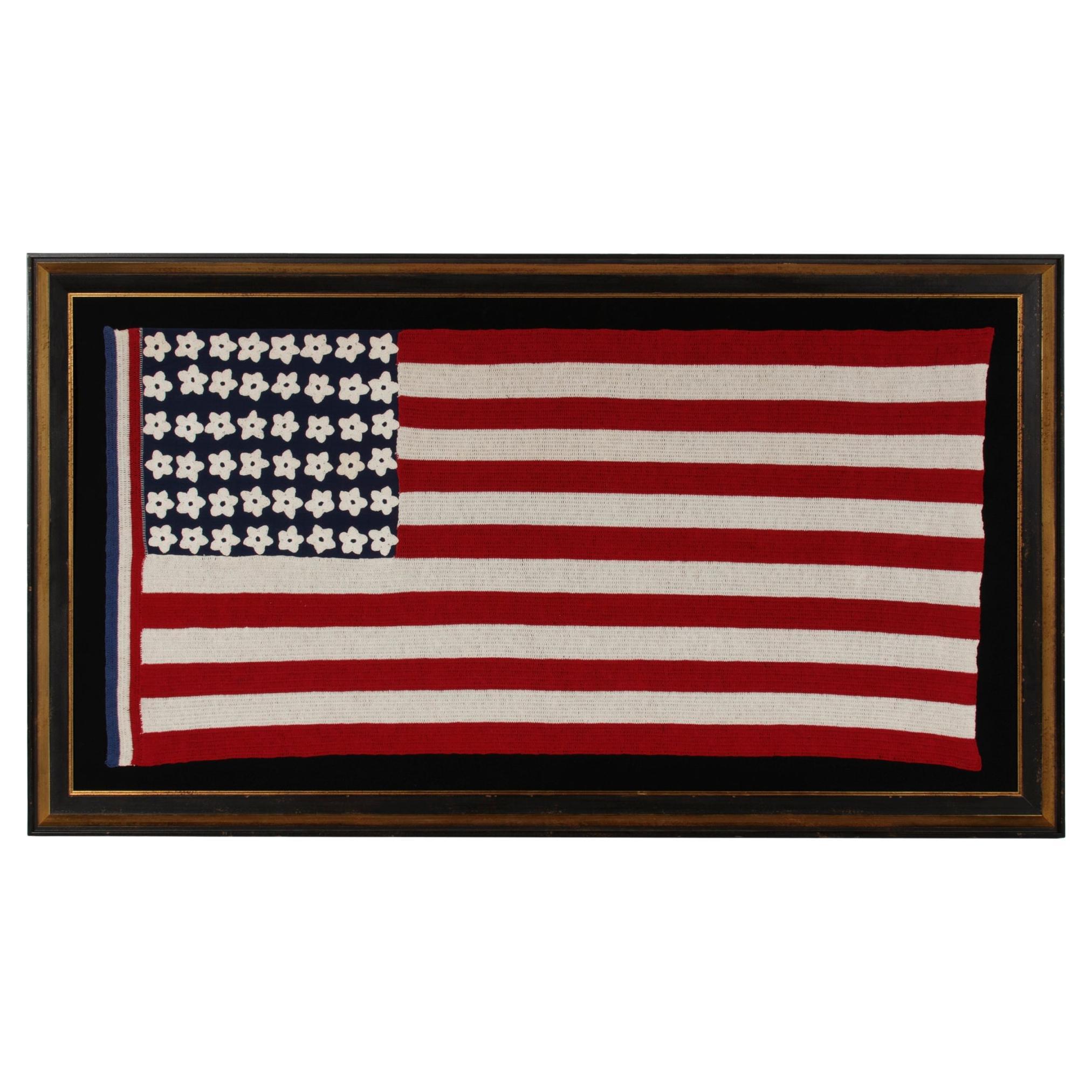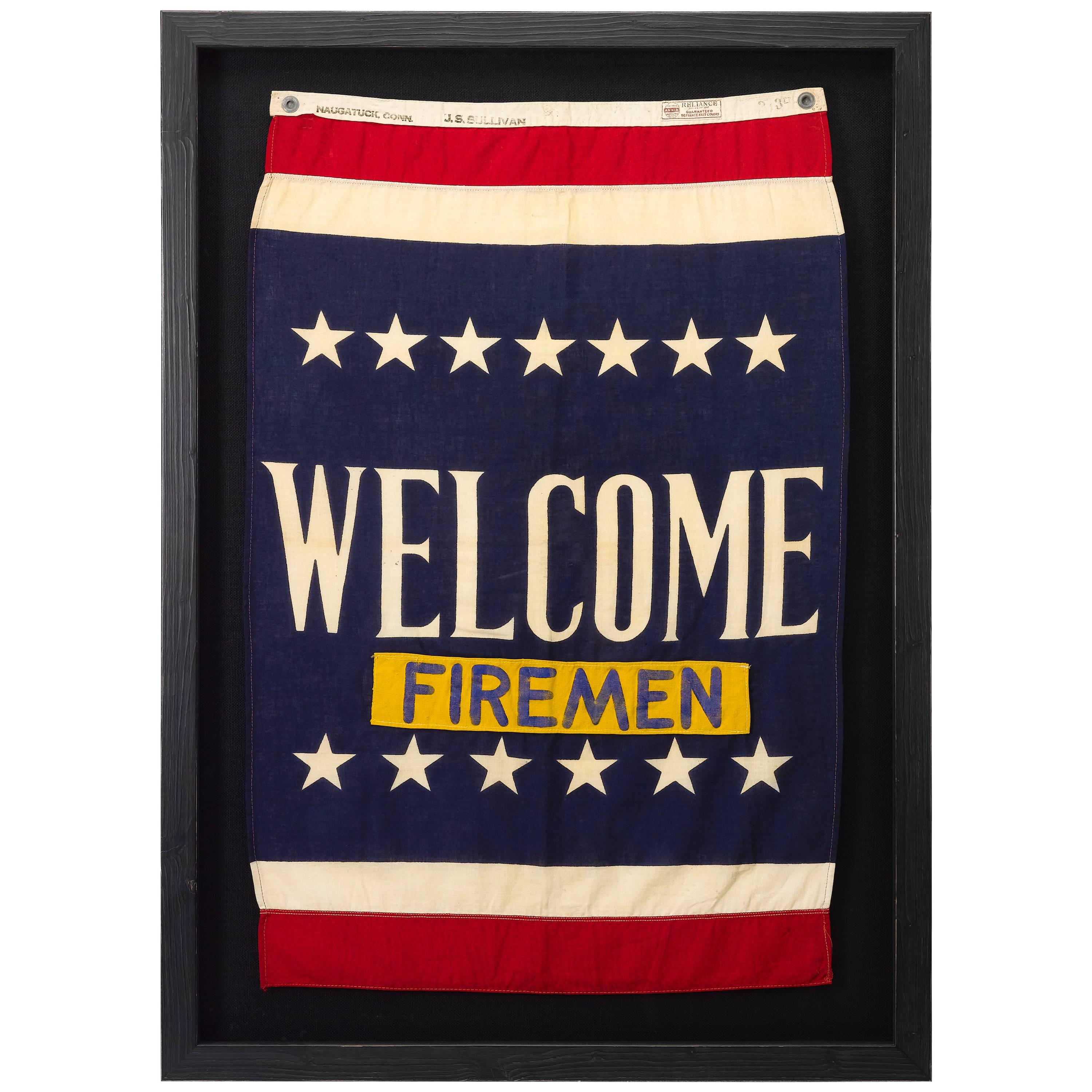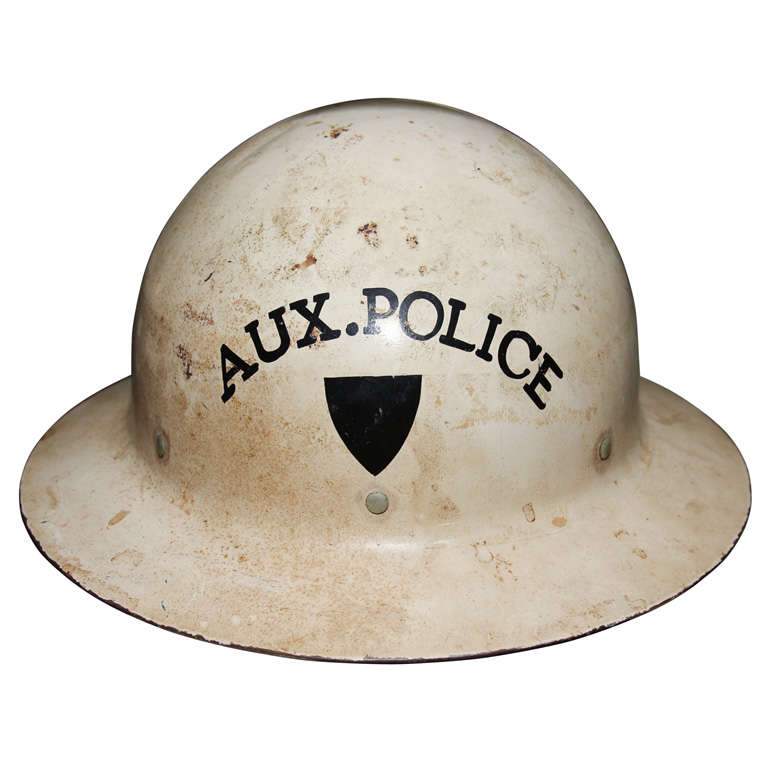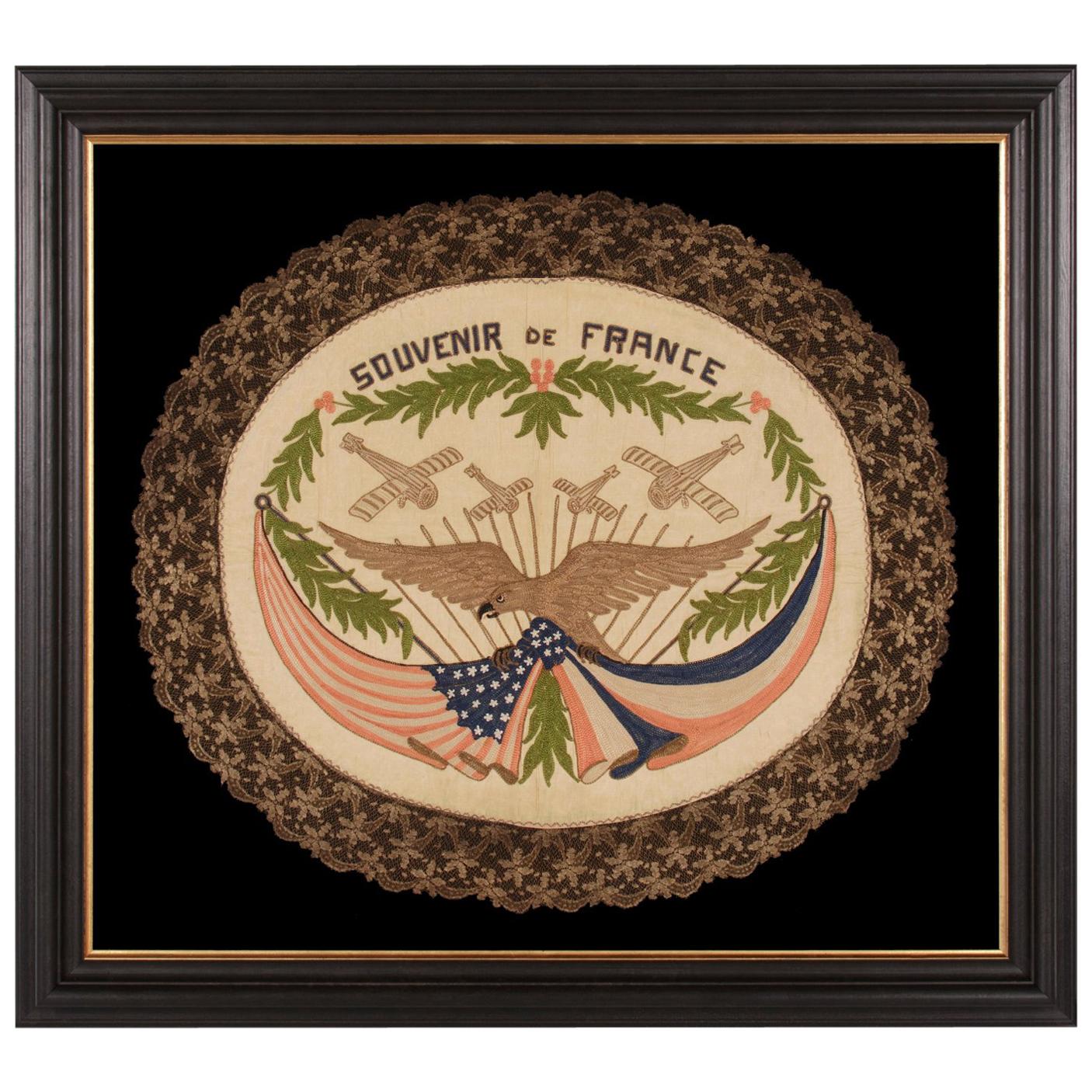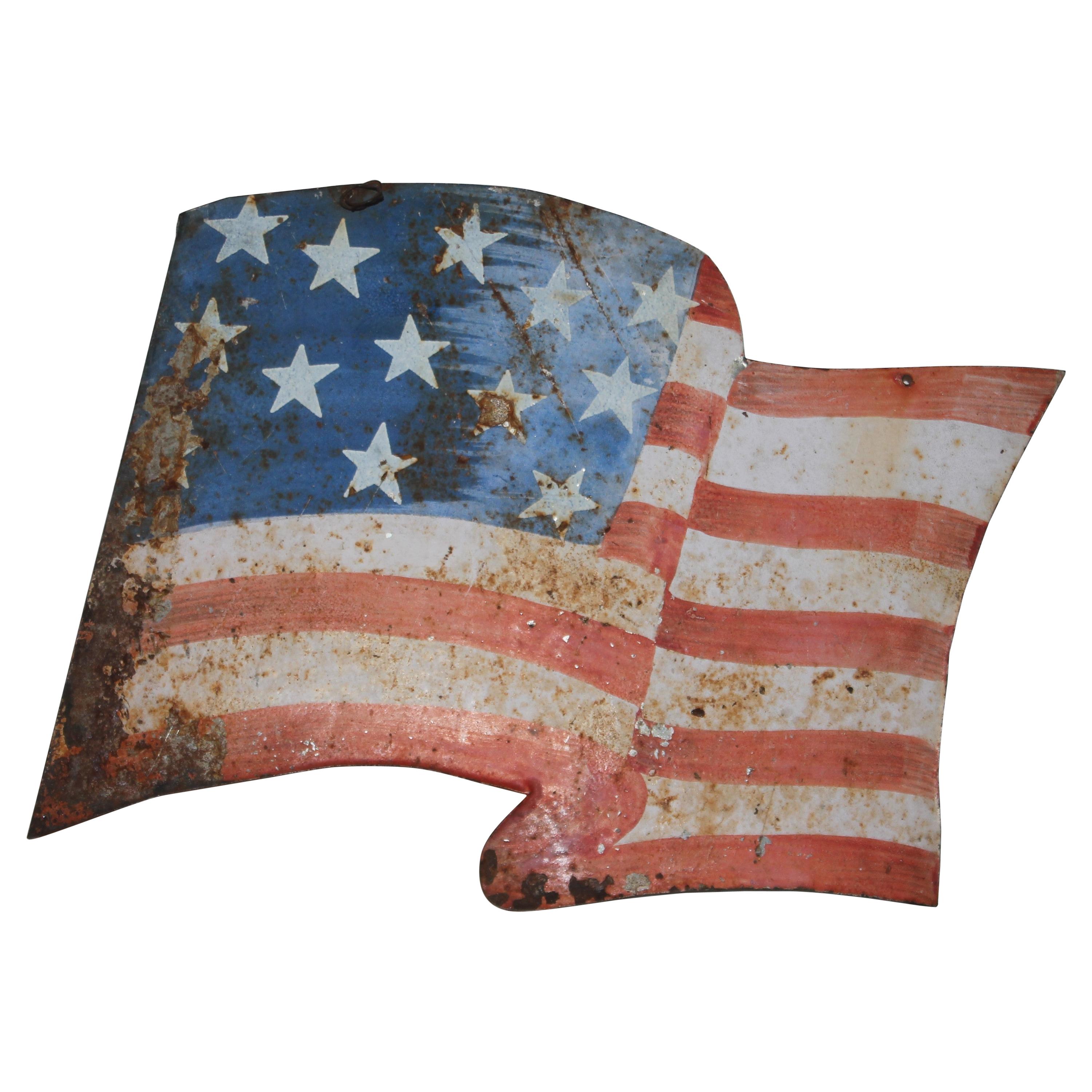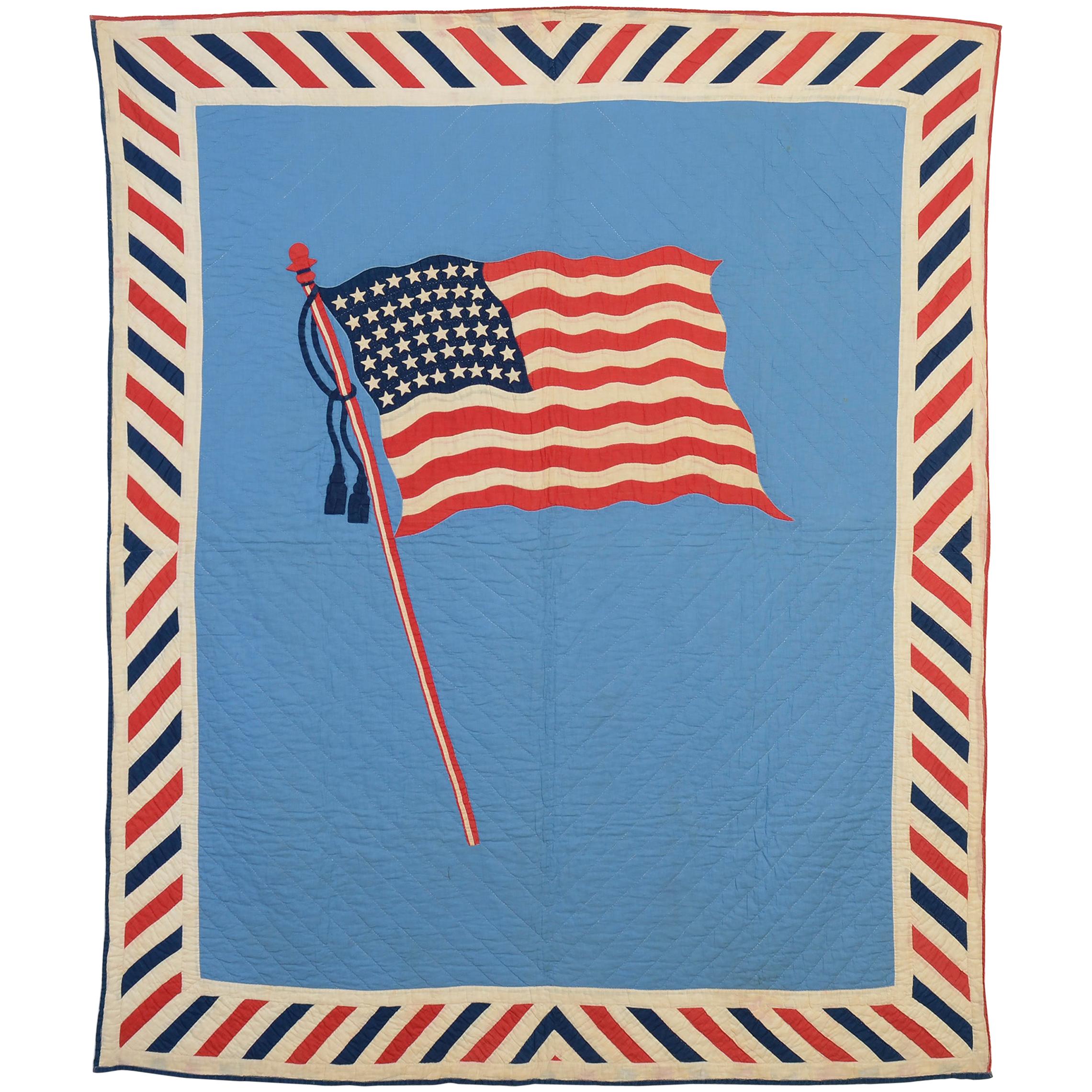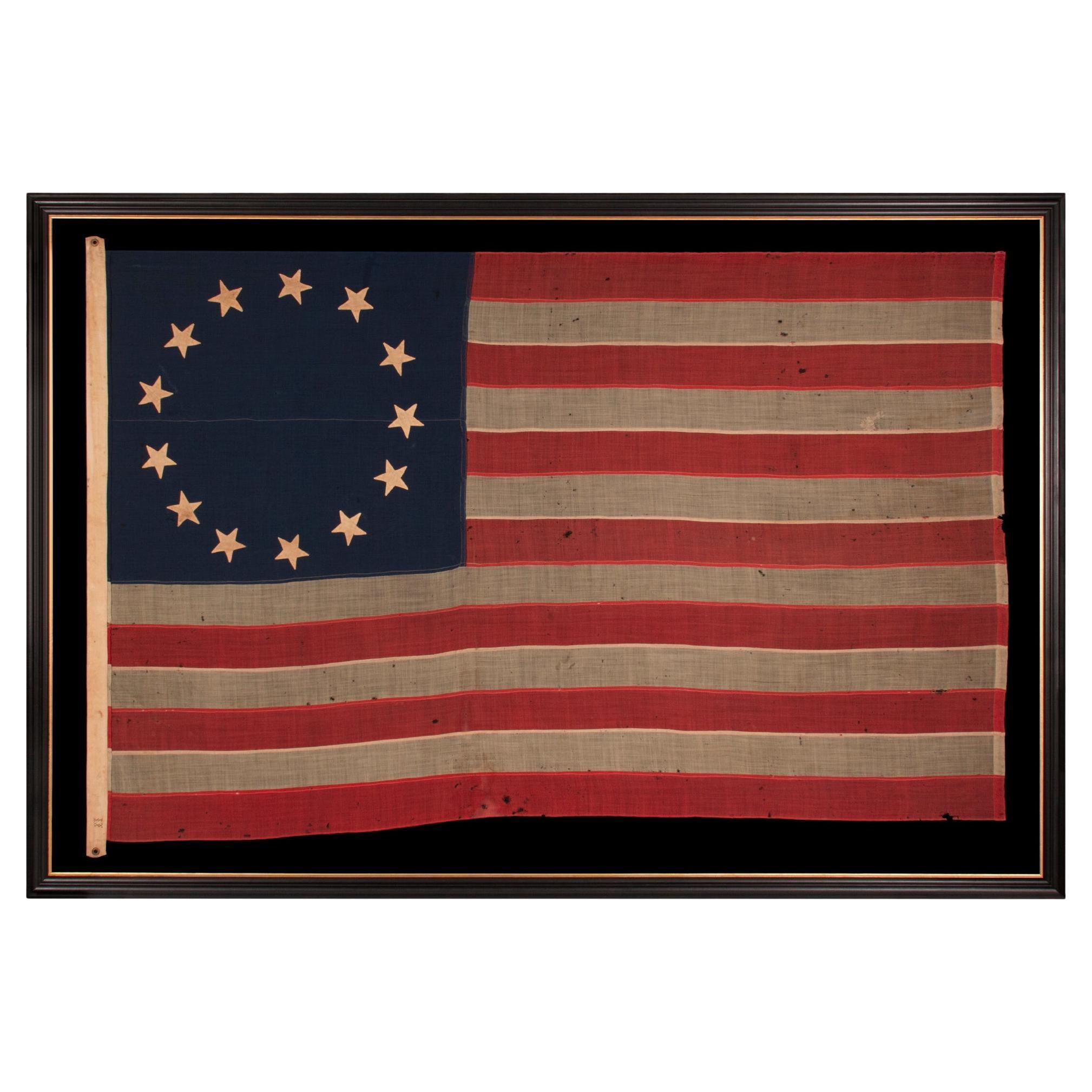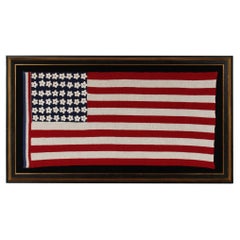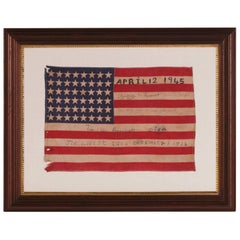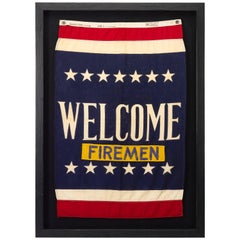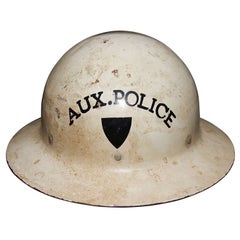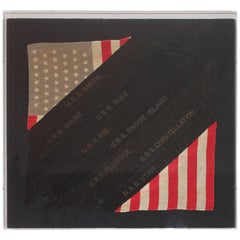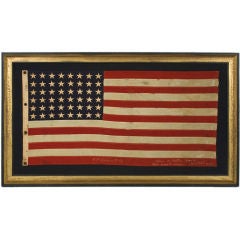
WWII BATTLE FLAG FROM THE U.S.S. FLINT
View Similar Items
Want more images or videos?
Request additional images or videos from the seller
1 of 7
WWII BATTLE FLAG FROM THE U.S.S. FLINT
About the Item
This extraordinary piece of history is a small-scale battle flag from the USS Flint (CL-97), a modified Atlanta-class cruiser (sometimes referred to as Oakland class cruiser), brought home by the ship’s 2nd Lt. L. W. Perrine. Past the sheer scarcity of WWII, military production, U.S. Navy Battle flags in the open market that were flown during wartime, the primary thing that makes this flag special is that either the sailor or one of his family members embroidered the bottom stripe with his name, the use of the flag, dates of service, and the name of the ship. This reads:
“F.W. Perrine F 2/C [Fireman, 2nd Class]”
Followed by:
“Flown in Battle Aboard
From 0/1/44 to 6/1/46. U.S.S. Flint CL97”
Some Facts About the U.S.S. Flint:
The U.S.S. Flint was named after the city of Flint, Michigan. She was launched on 25 January 1944 by Bethlehem Steel Company of San Francisco, California, sponsored by Mrs. R. A. Pitcher. She was and commissioned on 31 August 1944, with Captain C. R. Will in command.
Though its service was late in the war, the USS Flint was extremely active and received four battle stars for World War II service.
Flint reported to the 3rd Fleet for duty at Ulithi on December 27th, 1944, and 6 days later, sailed with TF 38 for a month-long cruise in support of the invasion of Luzon. She screened aircraft carriers as they launched strikes on Luzon, Taiwan, and the China coast, and fired protective anti-aircraft cover during a Japanese kamikaze attack on 21 January 1945. Replenishing at Ulithi from 26 January to 10 February, Flint then sailed with newly designated Task Force 58 for air strikes on Tokyo preceding the attack on Iwo Jima. Her force arrived off Iwo Jima on 21 February to fly air support for the Marines who had landed two days previously, and Flint returned to Ulithi 12 March for a brief 2 days of replenishment.
Putting to sea with TF 58 for strikes against Kyūshū in preparation for the invasion of Okinawa, Flint aided in bringing down several airplanes in heavy attacks on the task force from 18 March to 22 March 1945. The task force then closed Okinawa, and Flint with other cruisers bombarded beach installations in preparation for the landings on 1 April. Aside from the period 14 to 24 May, when she was at Ulithi for upkeep, Flint operated off Okinawa until 13 June, when she anchored in Leyte Gulf.
Flint sortied from Leyte on 1 July 1945 to screen the final air attacks on the Japanese home islands and to join the bombardment of the east coast of Honshū until the cessation of hostilities. On 24 August, she took station off Nii Shima to serve as rescue ship and homing station for transport planes carrying occupation troops to Japan. Between 10 September and 15 September, she lay in Tokyo Bay, then sailed with a carrier task force to provide air and sea surveillance of Central Honshū until September 21st.
The cruiser made a voyage from Japan to Eniwetok, then loaded homeward bound servicemen at Yokosuka on 13 October 1945, bringing them into San Francisco Bay on 28 November. After sailing to Kwajalein to bring home more servicemen eligible for discharge, Flint reported at Puget Sound Naval Shipyard, Bremerton, Washington, on 11 January 1946, and there was placed out of commission in reserve at Bremerton on 6 May 1947, but was refurbished and reclassified CLAA-97 on March 18th, 1949. Her original dedication plaque currently rests in the Sloan Museum, in the city she is named after. [Source: Wikipedia]
Construction: The stripes and canton of the flag are made of wool bunting that has been joined with machine stitching. The cotton stars are double-appliqued (applied to both sides of the blue canton) with a zigzag stitch. There is a canvas sleeve with 4 heavy metal grommets, along which the following text was stenciled in black ink: “U.S. Ens. 11” (United States Ensign No. 11). The number was a code to indicate the size of the flag. It does not indicate feet in length; in fact, the larger the number, the smaller the flag. The text on the last stripe is embroidered in ivory white thread.
Mounting: The flag has been stitched to 100% silk organza on every seam and throughout the star field for support. Then flag was then hand-sewn to background of 100% cotton twill, black in color, which has been washed to remove excess dye. An acid-free agent was added to the wash and the fabric was heat-treated to further set the dye. The flag was then placed in a black-painted and hand-gilded, contemporary Italian molding. The front is U.V. protective acrylic.
- Period:
- Date of Manufacture:WWII
- Condition:There is moderate mothing, particularly in the white stripes. There is minor to moderate foxing and staining, accompanied by corrosion on the grommets. This is a beautiful state of preservation for a WWII flag that was actually flown in battle for a perio.
- Seller Location:York County, PA
- Reference Number:Seller: 48j-9131stDibs: U0908318497169
About the Seller
5.0
Recognized Seller
These prestigious sellers are industry leaders and represent the highest echelon for item quality and design.
Established in 1991
1stDibs seller since 2008
61 sales on 1stDibs
Typical response time: 10 hours
More From This SellerView All
- 48 Star Crocheted Homemade American Flag, WWII Era, 1941-1945Located in York County, PA48 star, crocheted, antique american flag of the wwii era (1941-1945), a beautiful, homemade example, with a red, white, & blue hoist and flower-like stars: Crocheted American fla...Category
Mid-20th Century American Political and Patriotic Memorabilia
MaterialsCotton
Price Upon Request - Franco-American Textile with the Image of an Eagle Holding the American and FlagLocated in York County, PAFranco-American textile with the image of an eagle supporting knotted and draped american and French flags beneath four war planes; embroidered silk floss and metallic bullion thread...Category
Mid-20th Century American Political and Patriotic Memorabilia
MaterialsSilk
- Antique American Flag w/ Hand-Written Inscriptions Mourning the Death of FDRLocated in York County, PA48 STARS ON ANTIQUE AMERICAN FLAG WITH HAND-WRITTEN INSCRIPTIONS AND AN EMBROIDERED DATE OF APRIL 12TH, 1945, MOURNING THE DEATH OF PRESIDENT FRANKLIN DELANO ROOSEVELT: American national parade flag with 48 stars, printed on cotton, embellished with hand-written inscriptions and an embroidered date to commemorate the death of FDR on April 12th, 1945. “On this day in 1945, President Franklin D. Roosevelt died of a massive cerebral hemorrhage at his Warm Springs, Georgia, retreat at the age of 63. Roosevelt’s death in the final months of World War II was met with shock and grief throughout the Western world. Many Americans had no inkling of his decline in health. [He] had been president for more than 12 years, longer than any other person. He led the country through some of its greatest domestic and foreign crises to the impending defeat of Nazi Germany and within sight of Japan’s surrender...Category
Vintage 1940s American Political and Patriotic Memorabilia
MaterialsCotton
- 36 Star Antique Flag, Nevada Statehood, with Stars in the "Great Star" PatternLocated in York County, PA36 STARS IN THE "GREAT STAR" OR "GREAT LUMINARY" PATTERN, ON A MERINO WOOL FLAG OF THE CIVIL WAR ERA WITH BEAUTIFUL SCARLET AND ROYAL BLUE COLOR AND WITH ITS CANTON RESTING ON THE "WAR STRIPE," REFLECTS NEVADA STATEHOOD, 1864-67 36 star antique American flag of the Civil War era, with some rare, desirable, and beautiful features. The most obvious of these is the configuration of the stars. These are arranged in what is known as the “Great Star” or "Great Luminary" pattern, a star made out of stars, which is one of the most graphic and desired geometric designs among flag enthusiasts. Nevada entered the Union as the 36th state on October 31st, Halloween, in 1864. Ushered in by Abraham Lincoln just eight days before the presidential election that resulted in his second term, the territory’s wealth in silver was attractive to a nation struggling with the debts of war and so increased support for the Republican ticket. The 36th star was officially added on July 4th, 1865, but since the flag makers generally cared very little about official star counts, the production of 36 star flags began much earlier. The makers of printed flags are known to have begun adding the 36th star as early as July of 1864, several months before the addition of Nevada actually occurred. This was a common practice during the late 19th century and is reflective of both the nation's desire for Westward Expansion and the hope of flag-makers to bring new star counts to market before their competitors. The 36 star flag was officially replaced by the 37 star flag in 1867, following the addition of Nebraska. Great Stars come in many forms. This particular example has a single center star, surrounded by a pentagon of 5 stars, set inside its star-shaped perimeter. Note how the Great Star is positioned with two points up instead of one and so is effectively upside-down with respect to modern convention. Unlike the current flag, versions of the Stars & Stripes made during the 19th century and prior often displayed stars that were varied or completely random in their rotation on a vertical axis. Note how the feature draws attention and is unusual to the eye, in addition to being visually appealing. Another interesting trait can be seen in the fact that the canton rests on a red stripe. When this scarce condition occurs, some flag historians have referred to it as the “blood stripe” or the “war stripe”, suggesting the flag was constructed in this manner when the nation was at war. In actuality, the placement probably occurred more often by accident. Not everyone knew where the canton was traditionally positioned, and because there was no official specification until 1912, there was no official placement. Whatever the case may be with regarding the reason, the war stripe feature is highly coveted by collectors. The stars of the flag are hand-sewn, made of cotton, and are double-appliquéd (applied to both sides). The canton and stripes of the flag are made of fine merino wool. These are beautiful, luxurious fabrics with strong royal blue and scarlet color. Every seam was joined with a row of hand-stitching, then finished with a row of treadle stitching. Instead of employing the selvage edge of the red fabric, the top and bottom edges of the flag were turned under and seamed by hand and the fly end was seamed in the same fashion. There is a narrow binding along the hoist, treadle-sewn and made of cotton. Along this five cotton tabs were affixed, each with a tiny brass ring, which suggests that the flag was probably affixed to a wooden staff with twine or ribbon and hand-carried. The name of "Stow" is inscribed along the hoist. This would be the name of a former owner. In the field of early American flags...Category
Antique 1860s American Political and Patriotic Memorabilia
MaterialsWool
- 13 Star Antique American Flag in the Betsy Ross Pattern, ca 1861-1865Located in York County, PA13 star antique American flag in the Betsy Ross pattern, one of just three examples that I have encountered that pre-date the 1890’s; an extraordinary find, civil war period (1861-1865) or just after, extremely large among its counterparts of all periods in this design: Exceptional, early, American national flag, with 13 stars arranged in the circular wreath pattern most often attributed to Betsy Ross. Since there was no official configuration for the stars of the American flag until 1912, when our nation received its 47th and 48th states, the design, before that time, was left to the whims of the maker. This led to an almost unimaginable spectrum of star arrangements on the American flag during the 18th and 19th centuries. Even within the 13 star count, alone, there are at least 80 known patterns—more than the average person would even think possible. 13 star flags have been made throughout American history, from at least June 14th, 1777, when the first Flag Act was passed by Congress, until the present. They have been continuously produced for reasons both patriotic and utilitarian. Because this was the original number of stars on the American flag, representing the 13 colonies, it was appropriate for any device made in conjunction with celebrations or notions of American independence. 13 star flags were thus displayed at patriotic events, including, but certainly not limited to, such occasions as Lafayette’s final visit, in 1825-26, the nation’s centennial in 1876, and longstanding celebrations of Independence Day. From at least 1840 onward, 13 star flags were produced for presidential campaigns, drawing a parallel between the past and present struggles for freedom, and were carried by soldiers, during the Mexican and Civil Wars, for the same purpose. Throughout history, and even today, they are boldly displayed at every presidential inauguration. 13 star flags were flown by American ships both private and federal. The U.S. Navy used 13 stars on the ensigns made for small boats, because they wished the stars to be more easily discernable at a distance. Private ships often copied Navy practice, and when commercial flag makers first began to produce flags with pieced-and-sewn construction, in small sizes, in large quantity, they frequently employed the 13 star count. Flags in the Betsy Ross design are widely admired, due to the longstanding popularity of the Ross family myth. While many Americans learned in grammar school that Betsy Ross made and designed our first flag, and that the stars appeared in a circular fashion, there is, unfortunately, no way to prove the claim. No colonial examples have survived with this pattern of stars. In fact, while arranging the stars in a single circle seems quite logical, among the various choices that might come to mind, early American flags with this star pattern are curiously absent. One of the interesting misconceptions about 13 star flags is that the Betsy Ross pattern, even if not the original design, must have been common in early America. Logic would suggest this, given the frequency with which it appears in modern times, but this isn’t actually the case. In fact, the pattern is seldom encountered anywhere until much later. In more than 30 years of buying and selling early Americana, and over 20 years of extensive focus on the American flag specifically, through aggressively buying, researching, evaluating, restoring, and curating exhibitions, I have thus far encountered just three examples of Betsy Ross pattern flags that I can confidently date prior to the 1890's. No one knows what the first flag looked like. While there is no precise reason that the Betsy Ross design could not have been the first, one of the best arguments against it, is illustrated by the simple fact that so many 13 star flags exist without it. If the Ross configuration was the original, it stands to reason that the pattern would have been reproduced with at least some degree of frequency. Research conducted by the National Museum of American History notes that the story of Betsy Ross making the very first American flag for General George Washington, in the company of George Ross and Robert Morris, entered into American consciousness about the time of the 1876 centennial. The tale was immensely popular among an American public eager for stories about the Revolution and its heroes. The first documentation of it appeared shortly beforehand, in 1870, in a paper written by Betsy’s grandson, William Canby, for the Pennsylvania Historical Society. At the time, Canby made no mention of how the flag was designed, save for the fact that it had 5-pointed stars, per his grandmother’s suggestion. Because no earlier documentation supports the story, most flag scholars feel it was a grand hoax, fabricated by Canby for his own interests. Nothing survives in the collective writings of the three men, for example, nor in records of their words and deeds, which are fairly extensive. As with most things, reality is perhaps somewhere in the middle ground, with some of the details based on fact and some on fiction, made up, misinterpreted, or imagined from family accounts. The first time that a star configuration gets attached to the Ross story appears to have occurred during the last decade of the 19th century. In 1892, Charles Weisgerber painted a nine-by-twelve-foot rendition of the fabled meeting between Betsy and George Washington, in which there is a flag with a circular wreath. Shortly afterwards, in 1898, Betsy’s granddaughter and great-granddaughter began to make flags in the East Wing of Independence Hall in Philadelphia, selling them to tourists while disseminating the family folk tale. In that same year, Weisgerber and a “group of concerned citizens” sought to preserve Betsy’s former Philadelphia residence at 239 Arch Street, where she lived at the time the flag would have been sewed. Weisgerber moved his family into the house and immediately opened to the public the room in which Betsy was said to have worked her magic. Ten-cent memberships were sold to fund renovations and donors received a small calendar, to which a cotton 13 star Betsy Ross pattern parade flag was affixed. The effects of these events caused the Ross legend to stick and the story, with the corresponding flag design, has appeared ever since in more places than one could ever hope to count. The stars of this particular flag are made of cotton, hand-sewn, and double-appliquéd (applied to both sides). The canton and stripes of the flag are made of wool bunting that has been pieced and joined with treadle stitching. There is a sailcloth canvas binding along the hoist, with two brass grommets, one each at the extreme top and bottom. Along this, on the obverse, near the bottom, are two, unusual characters, embroidered with brown thread. These may be letter “I’s,” possibly forming a the Roman Numeral “II.” They are followed by an inscription, in blue ink, that appears to read “A. N. Smith.” The first character is stylized, and may alternatively be a “D,” “H,” or perhaps a “J.” Note how the binding is extended beyond the top and bottom-most points. Though quite unusual, this is sometimes encountered in early examples. The folding of the wool bunting back onto itself, with the binding stitched so that part of the fold is exposed, tends to be an early characteristic. Common in Civil war flags...Category
Antique 1860s American Political and Patriotic Memorabilia
MaterialsCotton
Price Upon Request - 13 Star American Flag with Hand-Sewn Stars in the 3rd Maryland PatternLocated in York County, PA13 hand sewn stars in a circular version of what is known as the 3rd Maryland pattern, with an especially large center star, a flag with especially tiny scale among those with pieced-and-sewn construction, exceptionally rare, made circa 1890: 13 star flags have been flown throughout our nation’s history for a variety of purposes. They were hoisted at patriotic events, including Lafayette’s visit in 1824-25, the celebration of the centennial of American independence in 1876, and the sesquicentennial in 1926. They were displayed during the Civil War, to reference past struggles for American liberty and victory over oppression, and were used by 19th century politicians while campaigning for the same reason. As the number of stars grew with the addition of new states, it became more and more difficult to fit their full complement on a small flag. The stars would, by necessity, have to become smaller, which made it more and more difficult to view them from a distance as individual objects. The fear was that too many of them close together would become as one white mass and distort the ability to identify American ships on the open seas. Keeping the count low allowed for better visibility. For this reason the U.S. Navy flew 13 star flags on small boats. Some private ship owners mirrored this practice and flew 13 star flags during the same period as the Navy. Flag experts disagree about the precisely when the Navy began to revert to 13 stars and other low counts. Some feel that the use of 13 star flags never stopped, which seems to be supported by depictions of ships in period artwork. This was, of course, the original number of stars on the first American national flag, by way of the First Flag Act of 1777, and equal to the number of original colonies that became states. Any American flag that has previously been official remains so according to the flag acts, so it remains perfectly acceptable to fly 13 star flags today by way of congressional law. Since there was no official star configuration until the 20th century (1912 specifically, beginning with the 48 star count), the stars on 13 star flags may appear in any one of a host of configurations. Some of these are more rare and desirable than others. The stars of this particular flag are arranged in what has come to be known as the "3rd Maryland Pattern." This configuration, whether oval or circular, is appreciated both for its visual appeal and the scarcity of its use. a circular wreath of 12 with a single star in the center. The name comes from a flag that resides at the Maryland State Capitol in Annapolis, long thought to have been present with General Daniel Morgan at the Battle of Cowpens in 1781. According to legend, the flag was supposed to have been carried by Color Sergeant William Batchelor of the 3rd Maryland Light Infantry and was donated to the State of Maryland by Batchelor's descendants. The story was disproved in the 1970's, however, following an examination by the late flag expert Grace Rogers Cooper of the Smithsonian, who discovered that the Cowpens flag was, at the earliest, of Mexican War...Category
Antique 1890s American Political and Patriotic Memorabilia
MaterialsWool
Price Upon Request
You May Also Like
- Vintage WWII U.S. Navy Patriotic Banner, "Welcome Firemen" Flag, circa 1941-1945Located in Colorado Springs, COThis is a beautifully preserved WWII Navy aircraft carrier banner, emblazoned with a welcome for the ship's firemen. The banner is partially printed and has sewn elements. The flag's field is dyed a rich navy blue, with a resist dyed white stripe and a sewn red stripe at both top and bottom. A large "WELCOME" is resist dyed at center, in big white letters. This is followed by a sewn yellow strip of contrasting fabric, printed with the word "FIREMEN" in blue. Thirteen white stars complete the design of this patriotic piece of WWII and Navy history. The banner retains its original white hoist, with two metal grommets on each side, for ease in display on the ship. Along the center of the hoist is the printed name of "J.S. Sullivan." "Naugatuck, Conn." is printed along the left and the size "2 x3 FT" is printed along the right. The flag maker, Annin, has sewn in its label, boasting "guaranteed defiance fast colors." CONDITION: Very good condition, considering age and past use. Partially printed and hand-sewn flag construction. Some toning to the white of the flag and along the top hoist. Original grommets at left and right of the hoist. The flag measures 36" X 22". Expertly framed on black linen with an antiqued black wood...Category
Vintage 1940s American Political and Patriotic Memorabilia
MaterialsLinen
$2,500 Sale Price36% Off - WWII Auxiliary Police HelmetLocated in Seattle, WAIntact helmet from Auxiliary Police Force measurements are approximate- contact dealer for specificsCategory
Vintage 1940s American Political and Patriotic Memorabilia
MaterialsMetal
- Framed Hand Sewn Patriotic Sham Made from a Flag and Ship RibbonsLocated in Los Angeles, CAThis Great framed Folk Art sham with 48star flag and ship ribbons is a great patriotic item. The top left corner as well as the bottom right corner are scraps of a 48 star linen flag and in between them are ribbons of ships names that are sewn together in a collage. The American ships span three centuries of ships ribbons, from late 19th century to present day ships. As well as the "USS Utah" which was sunk during the attack on Pearl Harbor. This great and proud sham is not only a great American item but is a Symbol of hope and unity throughout the ages. Serves better as a hanging Folk Art...Category
20th Century American Folk Art Political and Patriotic Memorabilia
MaterialsPlexiglass
$1,195 Sale Price29% Off - Original Painted Metal Parade FlagLocated in Los Angeles, CAThis fun and folky 20thc original painted parade flag sign was used to hand in the windows during patriotic events. In stores and homes in the early 20thc.Category
Antique Late 19th Century American Adirondack Political and Patriotic Me...
MaterialsTin
$1,036 Sale Price20% Off - Patriotic Flag Quilt Old GloryLocated in Darnestown, MDNothing could be more of the moment than this patriotic flag quilt depicting Old Glory. It was most likely made either for the admission of Arizona into st...Category
Early 20th Century American Folk Art Quilts
MaterialsCotton
- Large 48 Star Embroidered Flag PillowBy American Flag & Banner Co.Located in Los Angeles, CAThis monumental 48 star flag pillow is in great in great condition and has a red cotton linen pillow. The big pillow id down and feather fill.Category
Mid-20th Century American Country Political and Patriotic Memorabilia
MaterialsCotton
$375 Sale Price36% Off
Recently Viewed
View AllMore Ways To Browse
Flag Bunting
Ensign Flag
Naval Flags
China Service For 12
Folk Art 18th C
Vintage U S Flag
WWII Flags
Vintage Battle Ship
Large Blue And White Pitcher
Embroidered Flag
Star Pitcher
China Sets Service For 12
Vintage Stars And Stripes Flag
Vintage Air Force 1
Blue And White Canton China
Fire Memorabilia
Small Blue Pitcher
Used Furniture Ky
